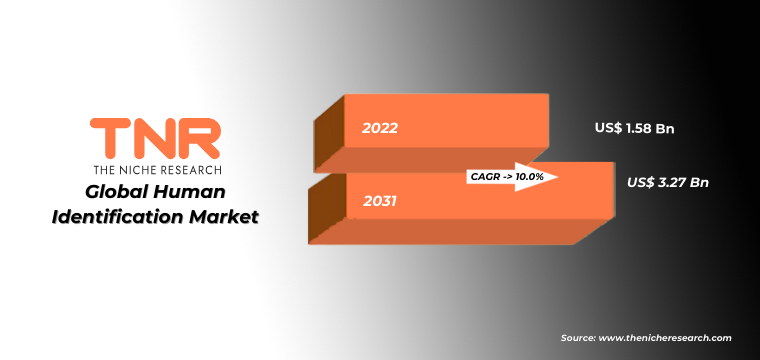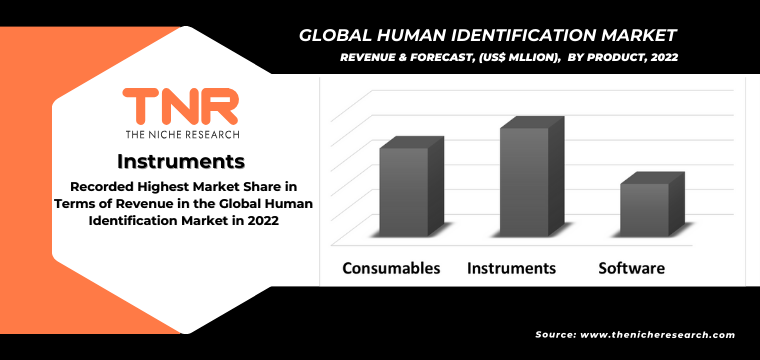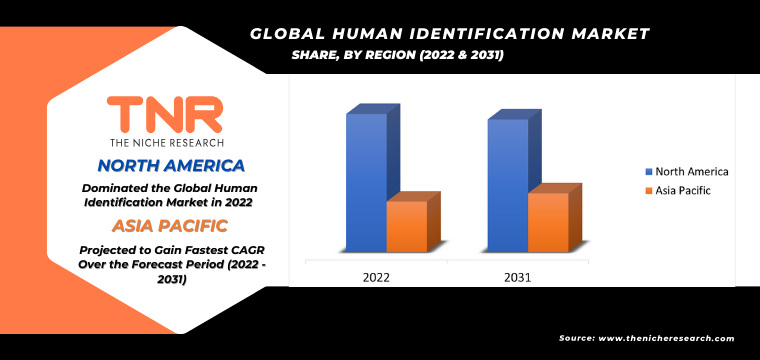Global Human Identification Market By Product, By Technology, By Application, By End User, By Region: Market Share & Analysis 2015 – 2031
- Industry: Healthcare
- Report ID: TNR-110-990
- Number of Pages: 420
- Table/Charts : Yes
- November, 2023
- Base Year : 2024
- No. of Companies : 9+
- No. of Countries : 29
- Views : 10177
- Covid Impact Covered: Yes
- War Impact Covered: Yes
- Formats : PDF, Excel, PPT
Global Human Identification Market was valued at US$ 1.58 Billion in 2022, growing at an estimated CAGR of 10.0% from 2023-2031.

Human identification is the precise establishment of an individual’s identity based on unique physical, biological, or behavioral traits. These include fingerprints, DNA, facial features, and voice patterns. Employed in law enforcement, border control, and access systems, it ensures accuracy using advanced biometric technologies. For instance, fingerprint recognition relies on distinct ridge patterns, while DNA profiling analyzes genetic markers. With advancements, methods like facial recognition and retina scans gain prominence. Accurate human identification is vital for security, privacy, and regulatory compliance, impacting various sectors from crime investigation to healthcare.

In the global human identification market, the instruments segment is dominating, while the consumables segment will be growing with the highest CAGR. The dominance of assay kits and reagents (consumables) is substantiated by their pivotal role in various human identification techniques such as DNA profiling. A survey conducted by the Forensic Science International: Genetics journal highlighted that DNA analysis is a primary method for human identification, where assay kits and reagents play a vital role. These kits enable efficient DNA extraction, amplification, and analysis, essential for accurate identification in forensic, paternity, and genetic testing scenarios.
COVID-19 Impact Analysis on Global Human Identification Market
Before the COVID-19 pandemic, the human identification market was steadily expanding due to advancements in forensic technologies, increased demand for paternity testing, and broader applications in healthcare and ancestry analysis. The market was characterized by a focus on improving accuracy, speed, and scalability of identification processes. However, with the onset of the pandemic, the market faced challenges such as disrupted supply chains for assay kits and reduced laboratory capacities due to diverted resources. Despite this, the pandemic underscored the importance of rapid identification in tracking virus transmission. Post-COVID-19, the market regained momentum as laboratories adapted to new safety protocols, and governments invested in contact tracing technologies.
A significant driver in the human identification market is the growing demand for forensic investigations. According to a report by the National Institute of Standards and Technology (NIST), DNA profiling is a vital tool in criminal investigations, aiding in identifying suspects and solving cases. The use of advanced DNA analysis techniques, such as next-generation sequencing (NGS), has enhanced the accuracy and efficiency of human identification. Ethical and privacy concerns pose a restraint on the human identification market.
A survey published in the “Journal of Medical Ethics” highlighted that genetic testing for identification purposes can infringe on individuals’ autonomy and privacy rights. The potential misuse of genetic information raises apprehensions about unauthorized access to personal data and its implications for discrimination and surveillance. While identification technologies offer valuable insights, striking a balance between their benefits and potential ethical challenges remains critical to prevent erosion of personal privacy and consent standards, affecting market adoption and growth.
 In the global human identification market, forensic applications are dominating, while paternity identification is experiencing highest growth. The dominance of “Forensic Applications” is substantiated by the significant role human identification plays in solving criminal cases and identifying victims. According to a survey conducted by the International Society for Forensic Genetics, DNA analysis is pivotal in criminal investigations, with over 80% of laboratories worldwide relying on DNA profiling. This reflects the crucial need for accurate and reliable human identification methods in law enforcement, contributing to the dominance of this segment.
In the global human identification market, forensic applications are dominating, while paternity identification is experiencing highest growth. The dominance of “Forensic Applications” is substantiated by the significant role human identification plays in solving criminal cases and identifying victims. According to a survey conducted by the International Society for Forensic Genetics, DNA analysis is pivotal in criminal investigations, with over 80% of laboratories worldwide relying on DNA profiling. This reflects the crucial need for accurate and reliable human identification methods in law enforcement, contributing to the dominance of this segment.
North America recorded highest market share in the global human identification market in 2022. The dominance is supported by its robust forensic infrastructure, advanced biotechnology research, and extensive implementation of DNA profiling for law enforcement and legal purposes. The Federal Bureau of Investigation’s Combined DNA Index System (CODIS) database, for instance, has assisted in solving numerous cold cases. This comprehensive forensic ecosystem, along with heightened public awareness, drives the prevalence of human identification technologies in the region.

Global Human Identification Market Snapshot
| Report Specifications | Details |
| Market Revenue in 2022 | US$ 1.58 Bn |
| Market Size Forecast by 2031 | US$ 3.27 Bn |
| Growth Rate (CAGR) | 10.0% |
| Historic Data | 2015 – 2021 |
| Base Year for Estimation | 2022 |
| Forecast Period | 2023 – 2031 |
| Report Inclusions | Market Size & Estimates, Market Dynamics, Competitive Scenario, Trends, Growth Factors, Market Determinants, Key Investment Segmentation, Product/Service/Solutions Benchmarking |
| Segments Covered | By Product, By Technology, By Application, By End User |
| Regions Covered | North America, Europe, Asia Pacific, Middle East & Africa, Latin America |
| Countries Covered | U.S., Canada, Mexico, Rest of North America, France, The UK, Spain, Germany, Italy, Nordic Countries (Denmark, Finland, Iceland, Sweden, Norway), Benelux Union (Belgium, The Netherlands, Luxembourg), Rest of Europe, China, Japan, India, New Zealand, Australia, South Korea, Southeast Asia (Indonesia, Thailand, Malaysia, Singapore, Rest of Southeast Asia), Rest of Asia Pacific, Saudi Arabia, UAE, Egypt, Kuwait, South Africa, Rest of Middle East & Africa, Brazil, Argentina, Rest of Latin America |
| Key Players | AutoGen Inc., Bio-Rad Laboratories, Inc., Carolina Biological Supply Company, GENETEK BIOPHARMA GmbH, Hamilton Company, INNOGENOMICS TECHNOLOGIES, LLC, Promega Corporation, QIAGEN, SecuriGene Technologies Inc., Thermo Fisher Scientific Inc., Other Market Participants |
| Customization Scope | Customization allows for the inclusion/modification of content pertaining to geographical regions, countries, and specific market segments. |
| Pricing & Procurement Options | Explore purchase options tailored to your specific research requirements |
| Contact Details | Consult With Our Expert
Japan (Toll-Free): +81 663-386-8111 South Korea (Toll-Free): +82-808- 703-126 Saudi Arabia (Toll-Free): +966 800-850-1643 United Kingdom: +44 753-710-5080 United States: +1 302-232-5106 E-mail: askanexpert@thenicheresearch.com
|
Competitive Landscape: Global Human Identification Market:
- AutoGen Inc.
- Bio-Rad Laboratories, Inc.
- Carolina Biological Supply Company
- GENETEK BIOPHARMA GmbH
- Hamilton Company
- INNOGENOMICS TECHNOLOGIES, LLC
- Promega Corporation
- QIAGEN
- SecuriGene Technologies Inc.
- Thermo Fisher Scientific Inc.
- Other Industry Participants
Global Human Identification Market:
By Product
- Instruments
- Consumables
- Software
By Technology
- Polymerase Chain Reaction
- Next-Generation Sequencing
- Capillary Electrophoresis
- Nucleic Acid Purification and Extraction
- Automated Liquid Handling
- Microarrays
- Rapid DNA Analysis
- Others
By Application
- Forensic Applications
- Paternity Identification
- Others
By End User
- Forensic Laboratories
- Research Centers, Academic and Government Institutes
- Others
By Region
- North America (U.S., Canada, Mexico, Rest of North America)
- Europe (France, The UK, Spain, Germany, Italy, Nordic Countries (Denmark, Finland, Iceland, Sweden, Norway), Benelux Union (Belgium, The Netherlands, Luxembourg), Rest of Europe
- Asia Pacific (China, Japan, India, New Zealand, Australia, South Korea, Southeast Asia (Indonesia, Thailand, Malaysia, Singapore, Rest of Southeast Asia), Rest of Asia Pacific)
- Middle East & Africa (Saudi Arabia, UAE, Egypt, Kuwait, South Africa, Rest of Middle East & Africa)
- Latin America (Brazil, Argentina, Rest of Latin America)
Table of Contents
**Exclusive for Multi-User and Enterprise User.
Global Human Identification Market
By Product
By Technology
By Application
By End User
By Region
**Note: The report covers cross-segmentation analysis by region further into countries
The Niche Research approach encompasses both primary and secondary research methods to provide comprehensive insights. While primary research is the cornerstone of our studies, we also incorporate secondary research sources such as company annual reports, premium industry databases, press releases, industry journals, and white papers.
Within our primary research, we actively engage with various industry stakeholders, conducting paid interviews and surveys. Our meticulous analysis extends to every market participant in major countries, allowing us to thoroughly examine their portfolios, calculate market shares, and segment revenues.
Our data collection primarily focuses on individual countries within our research scope, enabling us to estimate regional market sizes. Typically, we employ a bottom-up approach, meticulously tracking trends in different countries. We analyze growth drivers, constraints, technological innovations, and opportunities for each country, ultimately arriving at regional figures.Our process begins by examining the growth prospects of each country. Building upon these insights, we project growth and trends for the entire region. Finally, we utilize our proprietary model to refine estimations and forecasts.
Our data validation standards are integral to ensuring the reliability and accuracy of our research findings. Here’s a breakdown of our data validation processes and the stakeholders we engage with during our primary research:
- Supply Side Analysis: We initiate a supply side analysis by directly contacting market participants, through telephonic interviews and questionnaires containing both open-ended and close-ended questions. We gather information on their portfolios, segment revenues, developments, and growth strategies.
- Demand Side Analysis: To gain insights into adoption trends and consumer preferences, we reach out to target customers and users (non-vendors). This information forms a vital part of the qualitative analysis section of our reports, covering market dynamics, adoption trends, consumer behavior, spending patterns, and other related aspects.
- Consultant Insights: We tap into the expertise of our partner consultants from around the world to obtain their unique viewpoints and perspectives. Their insights contribute to a well-rounded understanding of the markets under investigation.
- In-House Validation: To ensure data accuracy and reliability, we conduct cross-validation of data points and information through our in-house team of consultants and utilize advanced data modeling tools for thorough verification.
The forecasts we provide are based on a comprehensive assessment of various factors, including:
- Market Trends and Past Performance (Last Five Years): We accurately analyze market trends and performance data from preceding five years to identify historical patterns and understand the market’s evolution.
- Historical Performance and Growth of Market Participants: We assess the historical performance and growth trajectories of key market participants. This analysis provides insights into the competitive landscape and individual company strategies.
- Market Determinants Impact Analysis (Next Eight Years): We conduct a rigorous analysis of the factors that are projected to influence the market over the next eight years. This includes assessing both internal and external determinants that can shape market dynamics.
- Drivers and Challenges for the Forecast Period:Identify the factors expected to drive market growth during the forecast period, as well as the challenges that the industry may face. This analysis aids in deriving an accurate growth rate projection.
- New Acquisitions, Collaborations, or Partnerships: We keep a close watch on any new acquisitions, collaborations, or partnerships within the industry. These developments can have a significant impact on market dynamics and competitiveness.
- Macro and Micro Factors Analysis:A thorough examination of both macro-level factors (e.g., economic trends, regulatory changes) and micro-level factors (e.g., technological advancements, consumer preferences) that may influence the market during the forecast period.
- End-User Sentiment Analysis: To understand the market from the end-user perspective, we conduct sentiment analysis. This involves assessing the sentiment, preferences, and feedback of the end-users, which can provide valuable insights into market trends.
- Perspective of Primary Participants: Insights gathered directly from primary research participants play a crucial role in shaping our forecasts. Their perspectives and experiences provide valuable qualitative data.
- Year-on-Year Growth Trend: We utilize a year-on-year growth trend based on historical market growth and expected future trends. This helps in formulating our growth projections, aligning them with the market’s historical performance.
Research process adopted by TNR involves multiple stages, including data collection, validation, quality checks, and presentation. It’s crucial that the data and information we provide add value to your existing market understanding and expertise. We have also established partnerships with business consulting, research, and survey organizations across regions and globally to collaborate on regional analysis and data validation, ensuring the highest level of accuracy and reliability in our reports.









